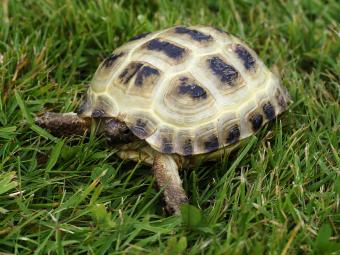
Pet parents need to do some homework to determine the kind of turtle they have at home. Each turtle or tortoise requires different food and overall care. There are over 250 different turtle species, so reptile lovers need to examine the pet's anatomy, shell, foot shape, and anything notable about the turtle's appearance.
What Kind of Turtle Do I Have?
An aquatic turtle needs an aquarium, and some terrestrial turtles do well outside. Once you determine the turtle or tortoise breed, the overall care for your pet is easy. With that in mind, some turtles and tortoises live for 70 to 100 years, so pet lovers need a plan!
Aquatic and Semi-Aquatic Turtles
Many of these turtles are bright with attractive markings, and others share the same colors as the natural surroundings. They all need a constant source of water, so look for webbed feet. The necks are longer than other types, as this trait allows this turtle to sit on the bottom of the tank and breathe.

Terrestrial Turtles
These turtles live primarily on land and may occasionally go into the water. They only go into the water to drink or bathe. Box turtles are all land species. Look for flat feet with long claws.

Tortoises
Tortoises need a different type of cage and one much larger than most aquariums. The enclosure also needs a heat source. The tortoise lives on land and rarely ventures into water except to drink or bathe. Tortoises are primarily herbivores, with hard shells and the feet are stumpy and padded.

Turtle Identification by Breed
Many popular turtle and tortoise species thrive as pets. Some of these turtles are known to come right up to you for food. Color, the shape of the shell, feet, behavior, and environment are all easy ways to recognize specific turtle and tortoise breeds. For example, the red-foot tortoise is popular among hobbyists and the adult's red feet are the main differentiator for this pet.
Red-Eared Slider
The red-eared slider's low, domed shell ranges in color from albino yellow to almost black. The yellow head markings and bright red spot behind the eyes are notable.

Bog Turtle
The brown shell with dark brown skin and the distinctive patch of bright yellow right behind its eyes and jaws make it easy to identify. The bog turtle's dorsal keel is a common feature.

Eastern Box Turtle
Look for a high-dome and golden color. This box turtle thrives in an outdoor enclosure and hibernates in the winter. One differentiator is the four toes on its back feet.

Gulf Coast Box Turtle
This turtle is a plain dark brown or black color with no or few markings. The Gulf Coast box turtle's large, domed upper shell is one way to identify this breed.

Wood Turtle
This breed is the most intelligent turtle in the world. The wood turtle is active and likes to dig, hunt, swim, and climb. This breed is a tan, grayish-brown, or brown color, with a central ridge and pyramidal groove pattern.

Red-Foot Tortoise
The adults are known for bright red feet. The concave, bumpy shell helps keepers identify this breed. Their skin is mostly black and shells are typically black, gray, or brown.

Pancake Tortoise
The pancake tortoise is easy to identify as this strange creature is known for the unique flat profile and relatively soft top shell. This trait allows the tortoise to squeeze between rocks.

Russian Tortoise
The upper shell is round and is as wide as it is long. The Russian tortoise has four toes, and the color ranges from light brown to yellowish-brown with extensive markings of dark brown on each scute, with a lower shell of black with yellow seams.

Hermann's Tortoise
The plastron's two connected black bands are along the central seam. The head color ranges from olive to yellow with dark patches. There is a characteristic yellow fleck on the cheek.

Leopard Tortoise
The leopard tortoise is one of the most attractive species with a yellow or cream background and black markings. It is a large tortoise and lives outdoors.

Turtles, Tortoises and the Law
Many states have laws that apply to turtles and tortoises. In some cases, the state laws follow the guidelines established by the Federal Endangered Species Act. Pet parents need to research the law to ensure it is safe for a pet turtle to live in the house.
Mimic the Turtles' and Tortoises' Natural Conditions
A reptile parent needs to know the kind of turtle so the habitat at home can mirror the pet's natural conditions. There are over 250 different species of turtles and tortoises. The laws may dictate the type of turtle you can own as some are endangered. The physical characteristics of each turtle breed help keepers determine if the species lives in water or on land. Tortoises are land-based, so these breeds are easier to identify based on specific traits.







